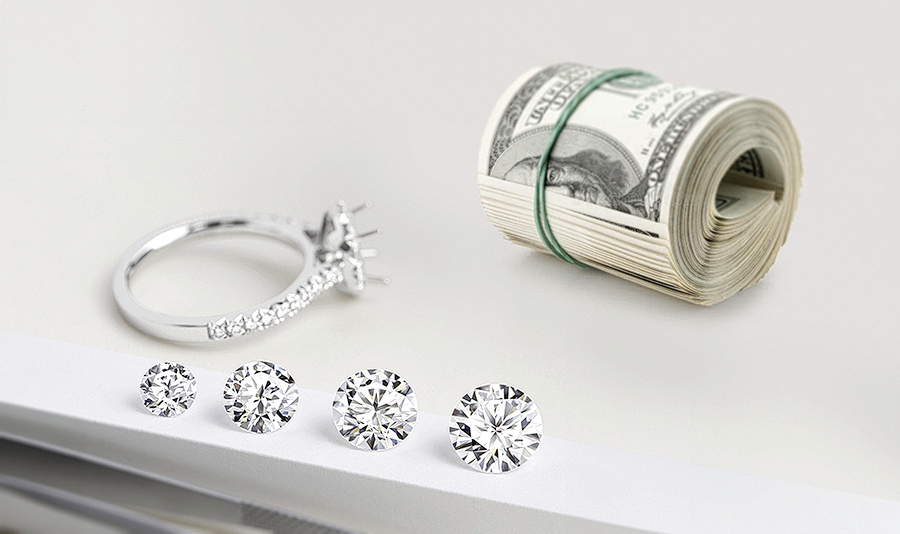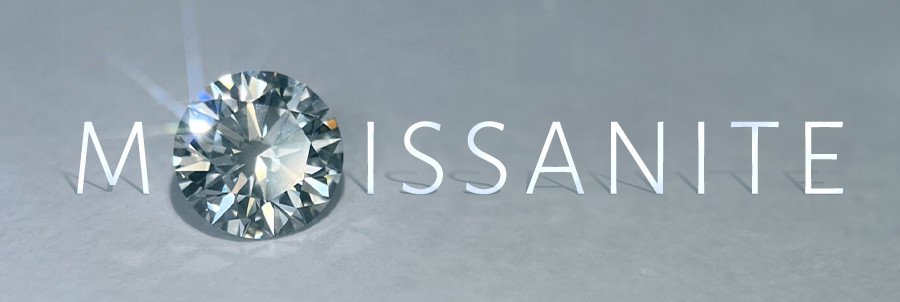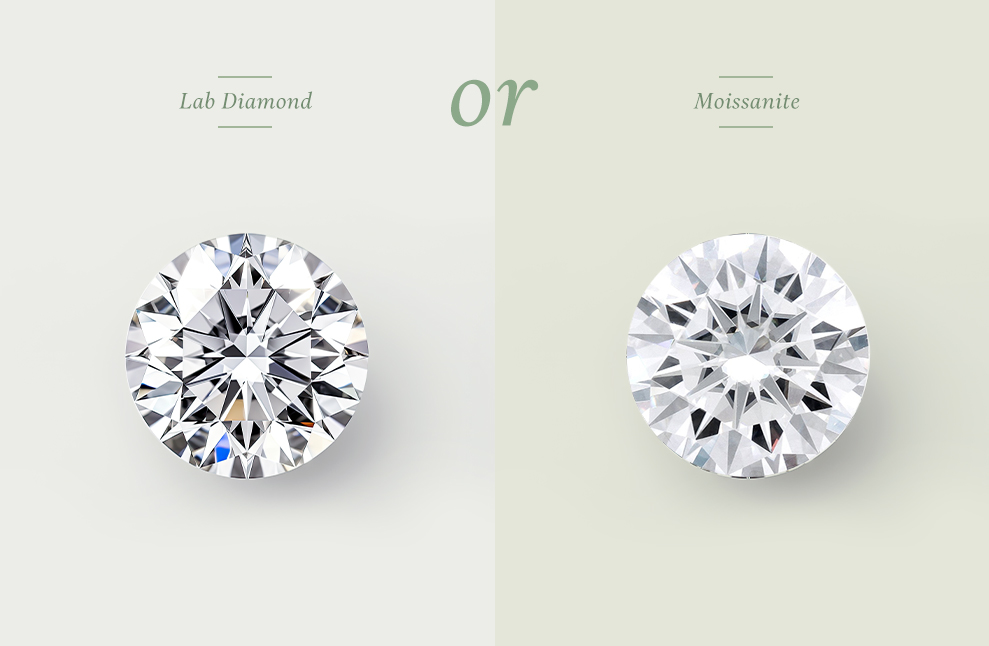Moissanite vs Lab Grown Diamonds: Key Differences Explained
No, Moissanite is not a lab-grown diamond – they are completely different gemstones. While both are created in laboratories, lab-grown diamonds are made of pure carbon and are chemically identical to natural diamonds, whereas Moissanite is made of silicon carbide. In this article, we’ll explore everything you need to know before making your purchase decision, from their unique properties to price differences and long-term value.
Many couples today are considering alternatives to traditional mined diamonds, drawn by the appeal of more affordable, ethical options. Whether you’re shopping for an engagement ring or fine jewelry, understanding the key differences between these stones will help you make an informed choice that aligns with both your budget and values.
What is the Difference Between moissanite vs lab diamond?
The answer to this question will help you decide which type of diamond jewelry is best for your budget and taste. Lab Diamonds or Moissanite are all different types of gemstones with similar appearance but with other characteristics.
| Types | Natural or Manmade? | Price | Brilliance and Fire | Hardness |
| Lab Grown Diamond | Man-made | 30%-50% less | Same | 10 in moh scale of hardness |
| Moissanite | Man-made | 50-90%% less | Same | 9.25 in Moh scale of hardness |
What is the Price Difference?
Lab grown diamonds are typically more expensive than moissanite. While the cost of moissanite is approximately $50 per carat, lab-grown diamonds average around $1,000 per carat, depending on quality. This makes moissanite a more affordable option for those seeking diamond alternatives, although lab-grown diamonds are still more budget-friendly than mined diamonds.
What is the Difference in Appearance?
Both lab created diamonds and moissanite are brilliant, white gemstones, but there are notable distinctions in their sparkle. Lab-grown diamonds have the same chemical composition as mined diamonds, resulting in a classic diamond sparkle with white light reflections. Moissanite, however, has a higher refractive index, which creates more colorful flashes, giving it a unique “disco-ball” effect. Some people find moissanite’s rainbow sparkle appealing, while others may prefer the more subtle brilliance of lab-grown diamonds.
All of these diamonds have their advantages and disadvantages. The main differences are how they’re grown, cut, polished, graded, and treated. Let’s take a look at each one.
Formation Process of Lab Grown Diamonds and Moissanite
Lab Grown Diamonds: These are created using two primary methods: High Pressure High Temperature (HPHT) and Chemical Vapor Deposition (CVD). Both methods replicate the natural conditions under which diamonds form, resulting in real diamonds that are chemically identical to mined diamonds.
Moissanite: Unlike lab grown diamonds, moissanite is made from silicon carbide. It is created by heating silicon carbide in an electric furnace, a process distinct from diamond synthesis.
Durability and Hardness Comparison
- Lab Grown Diamonds: With a hardness of 10 on the Mohs scale, they are the hardest known mineral, making them incredibly durable and ideal for everyday wear.
- Moissanite: Scores 9.25 on the Mohs scale, making it slightly less hard than diamonds but still very durable and suitable for daily use.
Ethical Considerations and Environmental Impact
- Lab-Grown Diamonds: Considered more ethical than mined diamonds as they do not involve destructive mining practices or exploitative labor. They are produced in controlled environments with minimal environmental impact.
- Moissanite: Also ethical and environmentally friendly, as it is lab created and does not require mining.
Alternative Diamond Options and Their Comparisons
- Natural Diamonds: Mined from the earth, they are often associated with environmental degradation and ethical concerns.
- Lab Grown Diamonds vs. Moissanite: Lab-grown diamonds are chemically identical to natural diamonds, while moissanite offers a more affordable alternative with a different chemical composition.
The Sparkle Factor – Analyzing the Brilliance
- Lab Grown Diamonds: Have a brilliance similar to natural diamonds due to their identical structure.
- Moissanite: Known for its exceptional sparkle, moissanite has a higher refractive index than diamonds, resulting in more colorful flashes of light.
Identifying Synthetic Diamonds
Lab-grown diamonds can be identified using specialized equipment that detects growth patterns unique to synthetic processes. Moissanite can be distinguished from diamonds by its double refraction and unique sparkle.
The Heirloom Factor – Longevity and Value Over Time
- Lab-Grown Diamonds: While they have similar durability to natural diamonds, their resale value is generally lower due to market perceptions.
- Moissanite: It does not hold value like diamonds but remains a popular choice for its affordability and beauty.
Understanding What is Lab Grown Diamonds and Moissanite
Lab diamonds and moissanite represent two distinct choices in modern jewelry, though they’re often confused with each other. Lab grown diamonds are real diamonds created in controlled laboratory environments using advanced technology, composed of pure carbon and sharing identical properties with mined diamonds. Moissanite, on the other hand, is a different gemstone altogether, made from silicon carbide, offering similar beauty but with unique characteristics.
What is a Lab Grown Diamond?
Lab grown diamonds are created by using special techniques: the CVD diamond method and HPHT diamond method, to grow a diamond as a natural diamond in labs. They can be used as an alternative to mined diamonds because they are more affordable.
Lab grown diamonds are created by growing a seed diamond in a furnace at extremely high temperatures and under very high pressures applied by air blasts. Once the seed diamond has been grown, it is cut and polished with special machinery designed to achieve the same level of perfection as mined diamonds. They also come in many shapes and sizes, so they’re perfect for any jewelry design.
Is a lab grown a real diamond?
Yes, it’s real! It’s just grown artificially in a laboratory instead of being dug out of the ground. Lab diamond is not mined from the earth, but it still has the same physical, optical, and chemical properties as a naturally mined diamond.
Lab-grown diamonds have the same composition, size, and color as naturally mined diamonds without defects. These diamonds are produced in laboratories to verify genuine diamonds’ structural and physical characteristics after they are set into jewelry.
Does lab-grown have resale value?

Yes, lab-grown diamonds do have a resale value as mined diamonds. But it depends on the quality of the diamond. The market price of lab-grown diamonds varies depending on their quality and grade. If it were bought at a higher price, it would have a resale value.
The main benefit of lab-grown diamonds is their availability. Lab diamonds are now being produced in large quantities and are affordable for all. This has made them popular among buyers, especially those who want to save money on mined diamonds.
Will you regret buying lab grown diamonds?
No, you won’t regret buying lab-grown diamonds if you choose wisely. You should buy loose lab–grown diamonds only when you know what you’re getting yourself into. It would be best if you made sure that the lab-grown diamond you purchase is of good quality and meets your expectations before you go ahead and spend your hard-earned money on it.
Is lab grown diamonds ethical?
Yes, it is ethical. Lab-grown diamonds are ethically sourced. They are grown in a controlled environment where no harm is done to the environment. There are no harmful chemicals used during the growth process. So, they are safe to use and environmentally friendly.
Advantages and disadvantages of lab grown diamonds:
| Advantages | Disadvantages |
| Cheaper than mined diamonds | They are not mined naturally |
| Available in all shapes, colors, and sizes | Some people think that lab-grown diamonds are inferior to mined ones |
| Durable | They are not natural diamonds |
| Easy to clean and maintain | Not as expensive as natural diamonds |
| Hypoallergenic | They are more expensive than moissanite and American diamonds |
| Eco-friendly | |
| Non-toxic |
What is a Moissanite?

Moissanite is a synthetic gemstone that looks and feels similar to a real diamond but is not considered real. And it is usually white or slightly yellowish in color. Moissanite costs less than a real diamond or lab created diamond.
It is an artificial diamond manufactured using silicon carbide (SiC), a mineral composed of carbon and silicon atoms.
Is a Moissanite gem a real diamond?
No, it is not a real diamond because it does not meet the standards of a real diamond. A real diamond must contain high levels of carbon. On the other hand, Moissanite can be clear, and flawless, but with low carbon content. It is also known as simulated diamonds.
Does Moissanite have resale value?
No, it doesn’t have resale value. However, it is still considered a valuable gemstone. Because it is so much cheaper than an earth-mined diamond, many jewelers will offer discounts for Moissanite.
Will you regret Moissanite?
Not every time, but you may regret it later because it will not last forever. Moissanite is not as strong as a real diamond. Therefore, it can break easily. Also, it is not very resistant to heat. Moissanite is mainly used for affordable jewelry purposes.
Is Moissanite ethical?
Yes, Moissanite is ethical because it is not a real stone. It is just an artificial material. It is not mined from the earth like a natural diamond. It comes from a laboratory. So, it is ethical.
| Advantages | Disadvantages |
| It is cheaper than an earth-mined and lab grown diamond | It is not as strong as a real diamond |
| It is more affordable than a lab-grown diamond | It may not last for a lifetime |
| It is easier to find in large sizes | It may change color over time |

